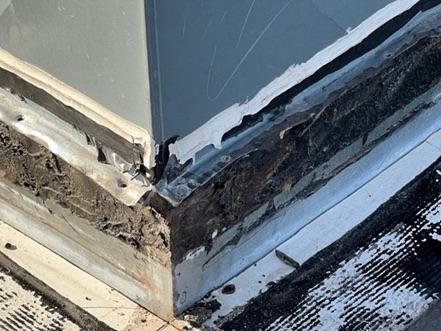Benchmark's Observations From the Roof Gallery
×
![]()

Issue: Based on recommendations by another company, a school district planned for the tear-off and replacement of a roof section that was approximately 15 years old. The roof section had a history of roof leaks.
Solution: Benchmark performed a roof evaluation and an infrared moisture scan to verify suspected wet insulation within the roof system. The evaluation revealed that the roof system had minimal wet insulation and that most of the past leaks were related to window and wall defects. Had the roof been replaced, water would have continued to enter the facility through walls and windows.
Possible Impact: The school district would have spent approximately $500,000 to replace a roof that only required repairs and spot replacement where wet insulation was found without resolving the issues resulting in water entry. By completing a roof evaluation and infrared moisture scan, the real source of water entry was identified, appropriate repairs were made to the walls and windows, and the school district saved over $400,000.

Issue: The Contractor failed to apply adequate weight to adhered insulation boards resulting in failed hot asphalt adhesion.
Solution: The loose insulation boards were removed and re-adhered in hot asphalt with proper weight applied after placement to ensure adequate adhesion.
Possible Impact: Poor adhesion increases the risk of failed wind uplift resistance, displaced insulation boards, and roof blow-off.

Issue: The Contractor failed to apply adequate weight to adhered insulation boards resulting in failed hot asphalt adhesion.
Solution: The loose insulation boards were removed and re-adhered in hot asphalt with proper weight applied after placement to ensure adequate adhesion.
Possible Impact: Poor adhesion increases the risk of failed wind uplift resistance, displaced insulation boards, and roof blow-off.

Issue: Corroded system fasteners were delivered to the job site with the intent to incorporate into the new roof system.
Solution: Benchmark directed the Contractor to remove the fasteners from the job site to prevent inadvertent use, and obtain and properly store new fasteners.
Possible Impact: If installed, these fasteners will continue to corrode, promoting corrosion to fastener seam plates and the steel deck, ultimately resulting in areas of failed wind uplift resistance.

Issue: Corroded system fasteners were delivered to the job site with the intent to incorporate into the new roof system.
Solution: Benchmark directed the Contractor to remove the fasteners from the job site to prevent inadvertent use, and obtain and properly store new fasteners.
Possible Impact: If installed, these fasteners will continue to corrode, promoting corrosion to fastener seam plates and the steel deck, ultimately resulting in areas of failed wind uplift resistance.

Issue: Field membrane lap seams were “cold welded” due to a faulty portable gas-powered generator.
Solution: Two field membrane seams were covered with hot air welded membrane strips.
Possible Impact: This project was at a hospital, over a complex of operating rooms. Had the cold-welded field membrane seams not been identified and repaired, they would have eventually become open laps, allowing a large amount of water to enter the building.

Issue: Field membrane lap seams were “cold welded” due to a faulty portable gas-powered generator.
Solution: Two field membrane seams were covered with hot air welded membrane strips.
Possible Impact: This project was at a hospital, over a complex of operating rooms. Had the cold-welded field membrane seams not been identified and repaired, they would have eventually become open laps, allowing a large amount of water to enter the building.

Issue: An area of new roof installation was located directly above several wall-mounted exhaust fans. New gutters had not yet been installed, and water could potentially drain over the open eave, directly into the exhaust fans.
Solution: Benchmark directed the roofer to install a temporary gutter system above the wall-mounted exhaust fans to divert water to the sides of the wall openings.
Possible Impact: This roof area was located above active food production. Water infiltration into the production area could potentially cause a production stoppage. Considering all aspects of potential impact to interior activities during roof replacement ensures the client can proceed with business as usual while work is being performed.

Issue: While performing construction observation, the Benchmark Field Consultant observed areas of damaged and deteriorated ductwork within the project area. This condition was not addressed within the scope of the roof replacement project.
Solution: Benchmark informed the client of the condition of the ductwork and recommended replacement in conjunction with the roofing project.
Possible Impact: Had this condition not been identified, the owner may have been unaware of the issue for some time. Water likely would have continued to infiltrate the building after the new roofing system was installed, resulting in frustration along with more repairs and expense to the owner.

Issue: While performing construction observation, the Benchmark Field Consultant observed areas of damaged and deteriorated ductwork within the project area. This condition was not addressed within the scope of the roof replacement project.
Solution: Benchmark informed the client of the condition of the ductwork and recommended replacement in conjunction with the roofing project.
Possible Impact: Had this condition not been identified, the owner may have been unaware of the issue for some time. Water likely would have continued to infiltrate the building after the new roofing system was installed, resulting in frustration along with more repairs and expense to the owner.

Issue: In the process of removing an existing roof curb, the roofer did not realize the duct seams were not sealed and air was escaping from the gap. This duct leak was located below the level of the new roof curb he was installing.
Solution: The Benchmark Field Consultant instructed the roofer to pause the installation of the new roof curb and seal the duct seams with sealant tape to make the joint airtight.
Possible Impact: This condition would have resulted in air being forced under the new roofing system, potentially causing moisture and pressurization issues that may have resulted in premature roof failure, not to mention reduced HVAC performance to the client.

Issue: In the process of removing an existing roof curb, the roofer did not realize the duct seams were not sealed and air was escaping from the gap. This duct leak was located below the level of the new roof curb he was installing.
Solution: The Benchmark Field Consultant instructed the roofer to pause the installation of the new roof curb and seal the duct seams with sealant tape to make the joint airtight.
Possible Impact: This condition would have resulted in air being forced under the new roofing system, potentially causing moisture and pressurization issues that may have resulted in premature roof failure, not to mention reduced HVAC performance to the client.
×
![]()






















